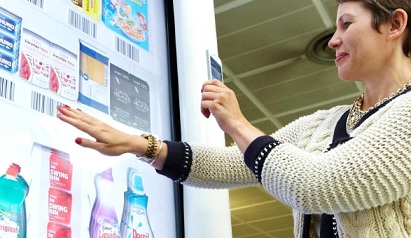 You’re in a new city, with an hour before a business meeting. You need to focus on your presentation, but you also need something to eat. Your connected watch finds several local quick-service restaurants and chooses one based on how busy it is, your company expense policy and your dietary preferences—using your vital signs to ensure you’re eating a balanced diet. (Did you really have bacon maple pancakes for breakfast?). While you keep working, the watch tells your self-driving car to take you to the restaurant. Based on local traffic, the watch will alert you when it’s time to leave for your meeting. And because you’re in a hurry, it will pay the bill. Hopefully, it will leave an appropriate tip.
You’re in a new city, with an hour before a business meeting. You need to focus on your presentation, but you also need something to eat. Your connected watch finds several local quick-service restaurants and chooses one based on how busy it is, your company expense policy and your dietary preferences—using your vital signs to ensure you’re eating a balanced diet. (Did you really have bacon maple pancakes for breakfast?). While you keep working, the watch tells your self-driving car to take you to the restaurant. Based on local traffic, the watch will alert you when it’s time to leave for your meeting. And because you’re in a hurry, it will pay the bill. Hopefully, it will leave an appropriate tip.
This magical world is closer than you think. There are apps to help you get smoothly from place to place, using up-to-date information about passenger loads on public transportation and traffic flows in the city. These apps will alert you to get off the train when you reach your destination, and can even share your progress with the friends you’re heading to meet. As for self-driving cars, they’re on our roads today, if few in number.
We’ve gotten used to emphasizing the divide between digital and physical, but it’s quickly disappearing: when digital data about the physical world is comprehensive, real-time and freely available, the physical and digital augment each other. This is most obvious in the navigation apps we use every day, which overlay digital maps with information about the physical world to create an augmented view far richer and more useful than either the physical or digital view alone.
E-commerce retailers also store performance metrics, such as the effect of promotions, in real time by adding a few lines of data capture code to a web page. This means that they can continuously tune behavior, for example based on reactions to offers and price changes, to provide the best outcome for consumers—and profits. Unlike most brick-and-mortar retailers, e-commerce retailers are not only born digital, they’re born global.
Bringing brick-and-mortar retailers to data parity with e-commerce won’t be easy. Retailers have been assembling a holistic view of their business for decades using data warehouses and business intelligence software. But that view is limited. Retailers generally don’t know if a consumer saw a display before making a purchase, and use analytic techniques to infer the effect of the display based on sales.
To get a complete picture of the physical retail environment, retailers must assemble and integrate data from many sources at scale and in real time; data has to be fresh and relevant when it’s used. For example, Walmart ingests over 200 streams of internal and external data, processing 2.5 petabytes of data every hour to create an integrated-reality view of its business.
Traditional data warehouse techniques can’t deal with the variety, volume and velocity of the data involved, and retailers have adopted the big-data and streaming technologies used by e-commerce companies. But not only do traditional retailers have to change their technology, they have to change their cultures as well. A recent survey of data analytics by McKinsey showed that the biggest difference between high and low-performing companies was not in their adoption of big-data tools, but that high performers were far more likely to make data accessible across the whole organization, provide business users with self-serve analytics, and make sure they had the tools and expertise to work with unstructured and real-time data.
How do brick-and-mortar retailers develop the capabilities and culture to make the necessary leaps? The most important thing they need to do is change the way they think about and manage data.
Established companies are still in the world of the highly structured enterprise data warehouse, rather than the “no schema” world of the digital titans. The enterprise data warehouse tried to model the business in a neutral and open-ended way, but most models were strongly influenced by the business’s operating practices and its view of the world.
By conforming to the business’s unique view of itself, enterprise models create inertia that works against change and constrains people’s ability to think creatively. Any uniqueness in the model also makes it harder for the company to share its information with third parties, or to incorporate data from third parties into its integrated reality. That’s an important consideration when you need over 200 sources of data to get a complete view of your business.
Because the world is changing unpredictably and your data-partner ecosystem is constantly evolving, it makes sense to describe your data in as neutral a way as possible, minimizing the proprietary aspects of the model by using open or industry standards. Frictionless data exchange is foundational to initiatives such as Industrie 4.0, which address the digitization of complex value chains through collaboration among enterprises, things and consumers—an “industrial” version of our example of the busy executive in the restaurant .
One of the best ways to make data comprehensible, useful and flexible is to keep it raw and let the data’s consumers decide how best to use it—rather than trying to preempt their needs by providing pre-cooked answers. Having extensive metadata is critical to this.
At the restaurant the busy executive visited in our earlier example, it’s important that his data-consuming device receive useful nutritional information about the available menu items. Classification schemes of the “healthfulness” of food that help an in-store consumer make an informed choice at a glance—a smiley or frowny face, or a red or green flash—don’t work in this scenario. Proprietary or semi-proprietary indicators make it impossible for the device to compare meals across restaurants reliably. Do three red dots mean the meal is spicy, high calorie, high fat, high salt, high sugar or all of the above?
Attempts to simplify proprietary schemes also break down as information that consumers want multiplies: allergies, gluten intolerance, dietary preferences, nutritional needs, sourcing and supply chain standards and so on. More importantly, they’re unnecessary in the digital world; the consumer has a digital assistant that knows their needs, wants, medical history and current physiological state, and is capable of understanding and analyzing a large amount of complex data on their behalf. The best thing is to provide the most complete, unprocessed data possible, and let the machines decide—both on the shelf and at the restaurant.
Once data is integrated automatically and in near real-time, it can be used to drive brick-and-mortar retail execution in a way that is competitive with e-commerce.
This automation ranges from things such as watching the supply chain for potential out of stocks to monitoring and tuning promotions. It will be a long haul, but it’s a necessary one.
Authored By Tom Edwards, SVP, Technology


